Newsletter Fall 2022

Growing Together

Photo courtesy Markus Spiske
“We are exploring together. We are cultivating a garden together, backs to the sun. The question is a hoe in our hands and we are digging beneath the hard and crusty surface to the rich humus of our lives.”
―Parker J. Palmer
Possibilities in the Garden
The Three Sisters
In the Process & Coffee learning circle, our group is finishing up the book Braiding Sweetgrass. In that book we learned about the Three Sisters. The Three Sisters method is a wonderful example of companion planting, with a trio of plants growing symbiotically to enrich the soil, and deter weeds and pests. Instead of the typical garden with single rows of a the same vegetable, this method of interplanting introduced biodiversity, which does many things—from attracting pollinators to making the land richer instead of stripping it of nutrients. This is a sustrable method that takes no more from nature than what is given back.
According to the Heritage Garden, "Corn provides a natural pole for bean vines to climb." Beans are nitrogen-fixers, improving the overall fertility of the garden by providing nitrogen. Bean vines also help "stabilize the corn plants, making them less vulnerable to blowing over in the wind. Shallow-rooted squash vines become a living mulch, shading emerging weeds and preventing soil moisture from evaporating, thereby improving the overall crops chances of survival in dry years. The spiny squash plants also help discourage predators from approaching the corn and beans. The large amount of crop residue from this planting combination can be incorporated back into the soil at the end of the season, to build up the organic matter and improve its structure."
Corn, beans and squash also complement each other nutritionally and can be eaten together in meals. Try this delicious Three Sisters stew recipe.
Corn provides carbohydrates, the dried beans are rich in protein, balancing the lack of necessary amino acids found in corn. Finally, squash yields both vitamins from the fruit and healthful, delicious oil from the seeds.
As older sisters often do, the corn offers the beans necessary support.
The pole beans, the giving sister, pull nitrogen from the air and bring it to the soil for the benefit of all three.
As the beans grow through the tangle of squash vines and wind their way up the cornstalks into the sunlight, they hold the sisters close together.
The large leaves of the sprawling squash protect the threesome by creating living mulch that shades the soil, keeping it cool and moist and preventing weeds.
The prickly squash leaves also keep away raccoons and other pests, which don’t like to step on them.

Image courtesy Garlan Miles
Gardening for the Common Good
Victory Gardens
“Sow the seeds of victory”
During World War I, a severe food crisis emerged in Europe as agricultural workers were recruited into military service and farms were transformed into battlefields. As a result, the burden of feeding millions of starving people fell to the United States. In March of 1917, just weeks before the United States entered the war—Charles Lathrop Pack organized the National War Garden Commission to encourage Americans to contribute to the war effort by planting, fertilizing, harvesting and storing their own fruits and vegetables so that more food could be exported to our allies. Citizens were urged to utilize all idle land that was not already engaged in agricultural production—including school and company grounds, parks, backyards or any available vacant lots. [source: History]
As part of the war effort in World War II, the government rationed foods such as sugar, butter, eggs, milk, cheese, and canned goods. So many men were serving in the armed forces and there was a shortage of labor that affected transportation and caused additional shortages. The government turned to its citizens and encouraged them to plant "Victory Gardens." They wanted individuals to provide their own fruits and vegetables. Nearly 20 million Americans answered the call. They planted gardens in backyards, empty lots and even city rooftops. Neighbors pooled their resources, planted different kinds of foods and formed cooperatives, all in the name of patriotism. [source: Wessels Living History Farm]
We did it before. Why not do it again?


Victory garden leaflet, Burpee Seeds, 1918
Urban Agriculture
A Blog Post by Stephen Yorba
What does it mean to be a process farmer? According to the Reverend Farmer Stephen Yorba, it’s about understanding our place in an ecosystem. It’s about remembering our relationship to the earth. It’s about being brought into right alignment with our food. It’s about slowing down, paying attention, and understanding how we’re all interconnected.
A Workshop by the Cobb Institute
Growing a vegetable garden, even a small one, or growing a few tomato plants in containers on your balcony, can restore something that has been lost. The corporate food industry has packaged, wrapped, imported, and separated us from the origins of our food. This four-session workshop is about reconnecting with our food, spiritually, and naturally. Gardening is holy work and growing healthy food invites us to listen to the earth. Happy Gardening!
Cobb Institue Garden Friends : A Photo Gallery

GROWING SEASON
Our mother of five often said, I don’t know how I would have fed all of you without the garden. It was our parent’s saving grace and our place to learn about tending the soil and preserving food. The garden centered us to the earth’s clock and we learned time could not be wasted as the growing season came and went at its own will.
Vegetable seeds or seedlings were planted in early spring as soon as the ground thawed. It was not unusual to grow several rows of corn in the rear section, tomatoes on stakes, bell peppers, lettuce, onions on the edge, root potatoes, carrots, radishes, beets, green beans on poles, peas, red cabbage, pumpkins for Hallowe’en, squash, cucumbers, rhubarb for pies, sunflowers on the south side. Our mother, a wonderful cook and baker, on a regular basis made summer-day lunches of fresh lettuce and tomato sandwiches on home-made bread.
With fruit trees on the lawn edging the garden, we had enough preserved and frozen fruit, produce, jams and jellies to take our family of seven through winter and the year. Even now, I know the fruit drill: strawberries in June followed by apples dropping all summer, green pears, purple plums, golden apricots, sour cherries, sweet cherries, red raspberries, and finally, two varieties of grapes from the arbor in September.
The first year of production was 1954 and as we all grew and left for college, the vegetable garden became smaller. But it easily sustained an eleven year run. By the late ‘60s, it too, became lawn.
© Veronica Michalowski
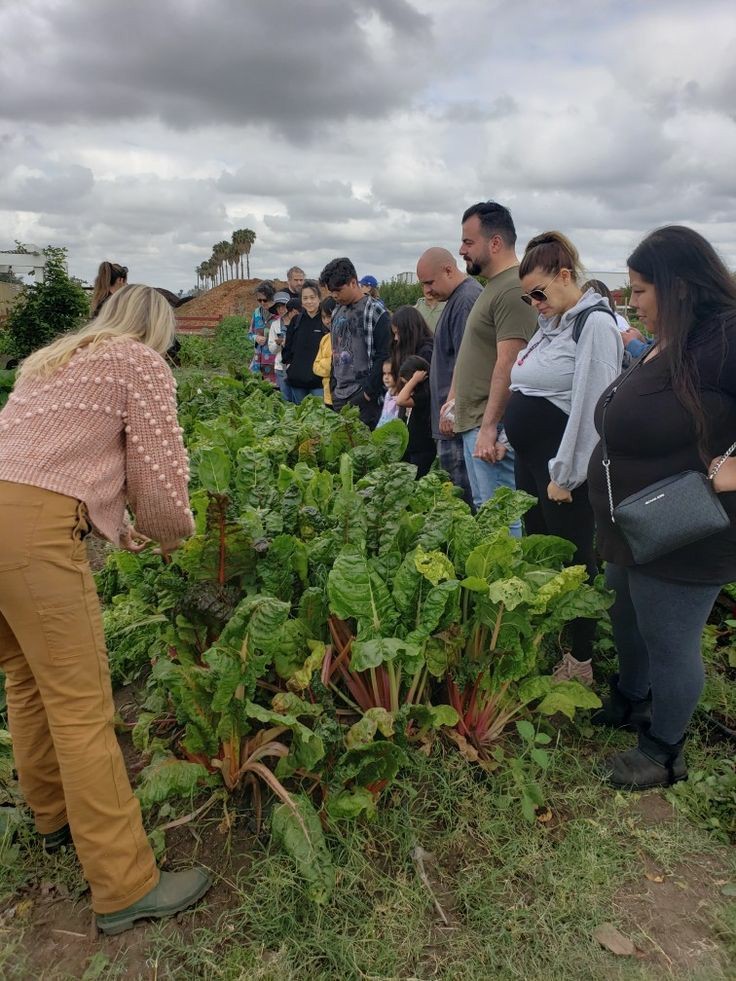
Above: Cobb Institute Eco Tour to Amy's Farm, a regenerative farm.
Below: John Cobb enjoying a salad with fresh vegatives from The Lopez Urban Farm in Pomona.
Photos by Kathleen Reeves

We might call this moment holy
for two or more
are gathered
in no one's name
but love
we do the work
of finding
our way
separately together
it's not really work
except in the way
I tend my garden
the way I kneel
before the tomato
seedlings and the milkweed
the way I pray
with hands
in soil
dirt under fingernails
the way I shed
the past
Into compost
creating and transforming
pain into nutrients
It’s like the way
I hope for a harvest
but sometimes fail
empty vines
empty baskets
the way I start again and again
the way body is like earth
sometimes so thirsty
waiting
for this drought
to end
and trusting that rain will come
By Kathleen Reeves
Below: A sucessful harvest from Kat Reeves' garden, tomatoes in a raised bed and a mini herb greenhouse. Success is not always the case. "I am still Learning", Kat said. "Listen and the earth will tell you what to do"


Below is A Japanese yuzu tree belong to Kat Reeves.


Below: The garden of Cobb Institute friend, Rolla Lewis



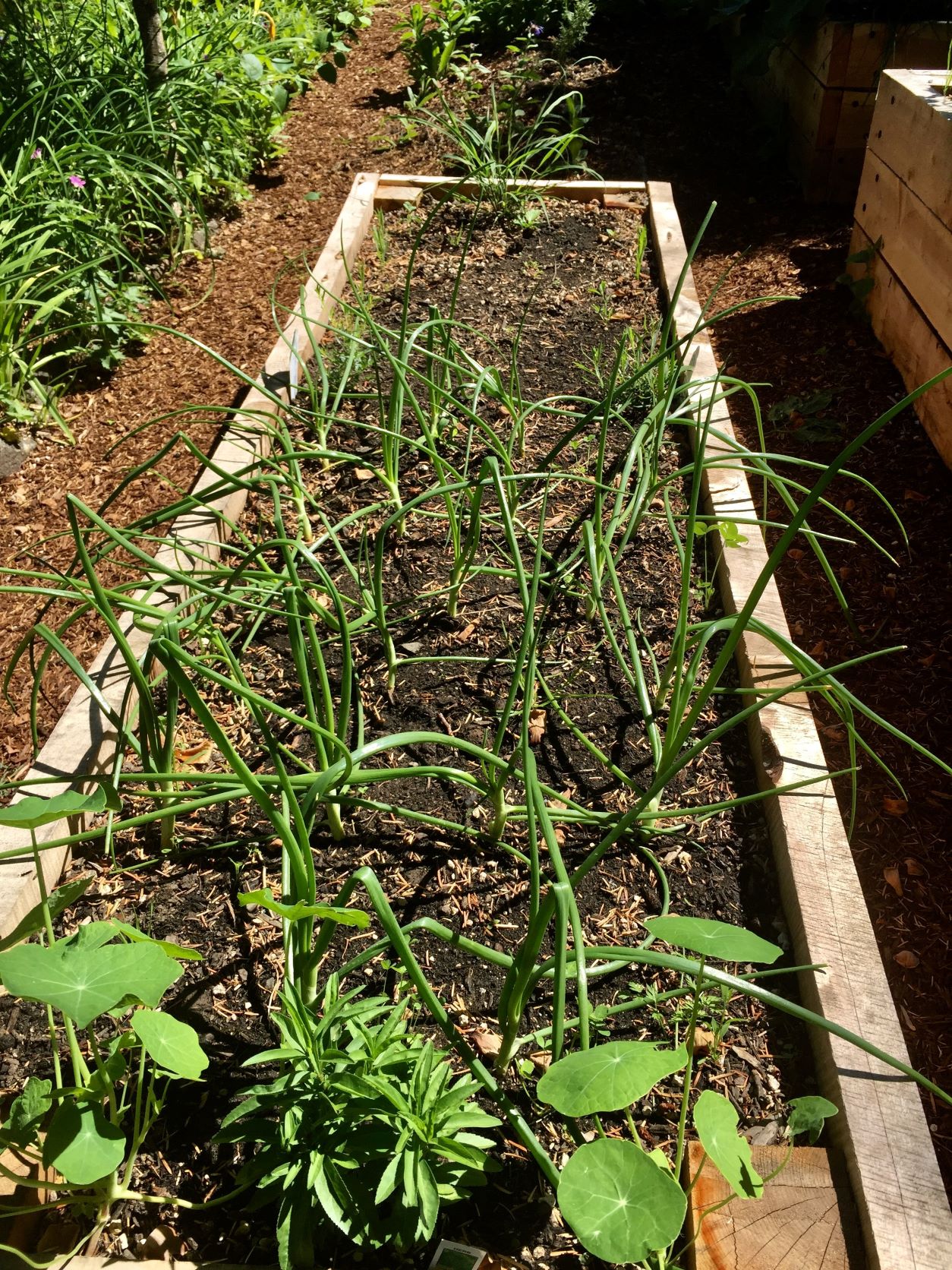
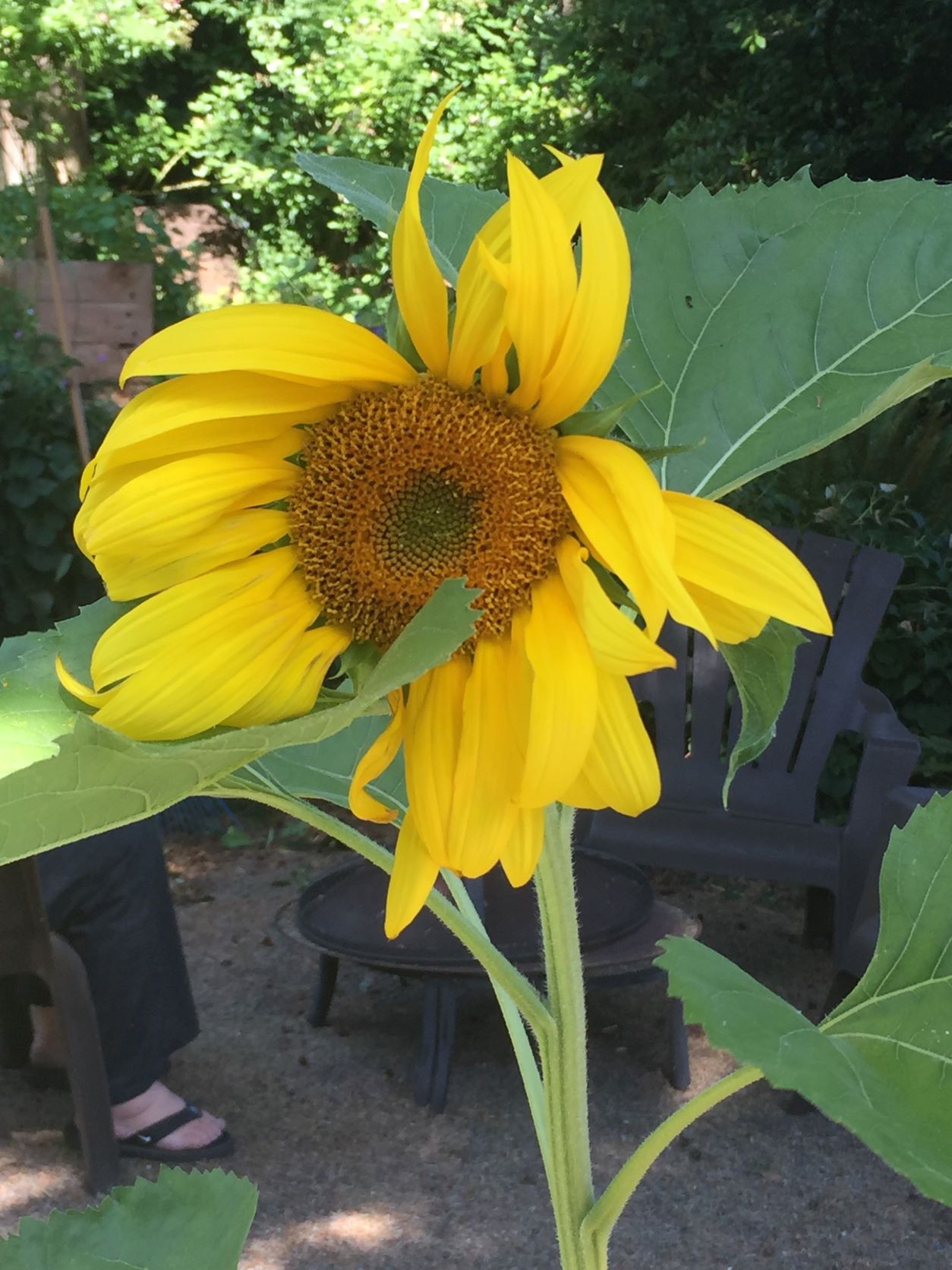
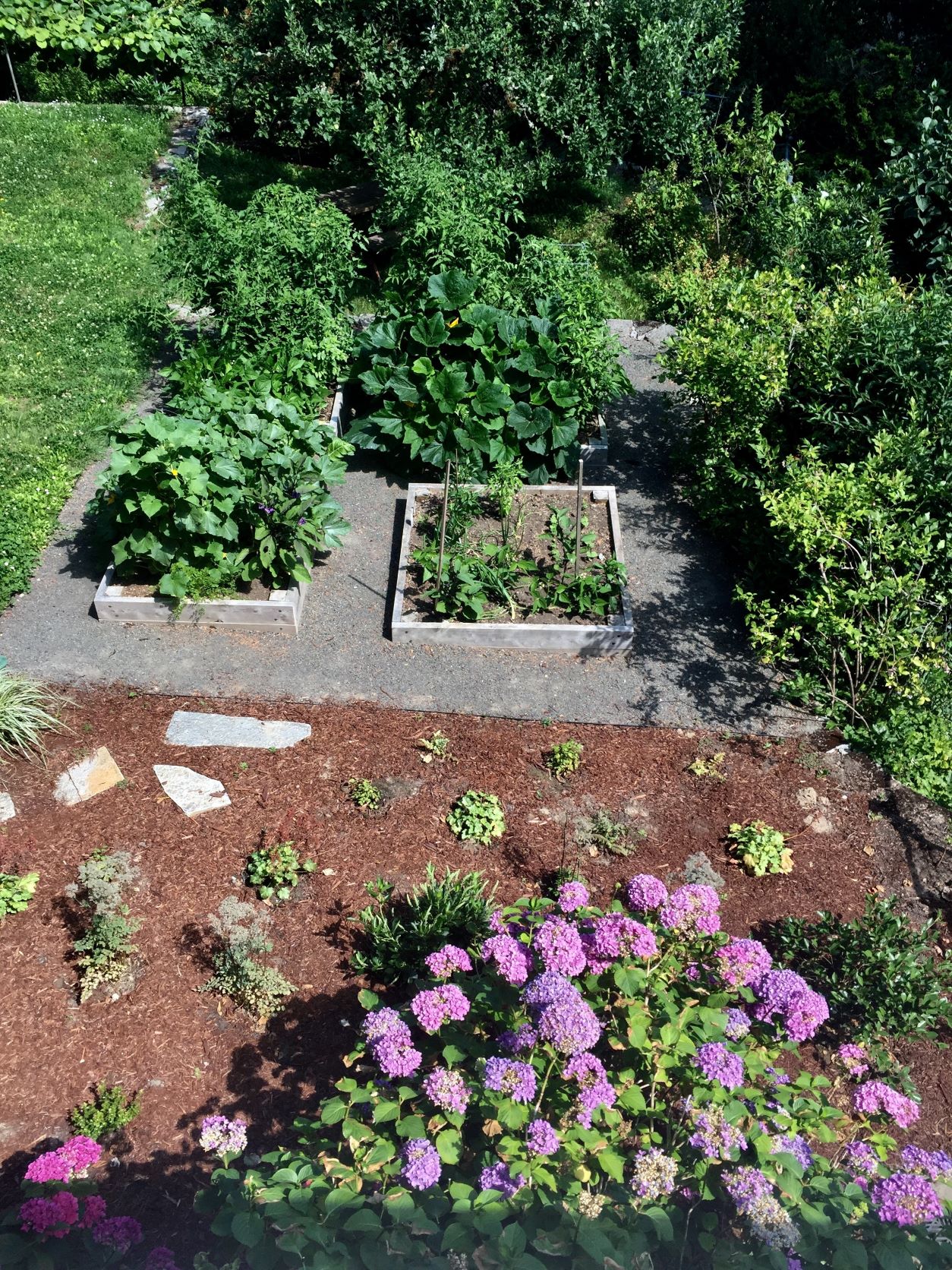
Below: Cobb Institute Eco tour at The Lopez Urban Farm in Pomona. Process farmer Stephen Yorba is showing the rows of vegetables and groves of fruit trees.

The Grape vine above is from Kat Reeves' garden last year. Sadly the grape vines were lost in the Claremont/Inland Empire wind storm of January 21st, 2022.
“The single greatest lesson the garden teaches is that our relationship to the planet need not be zero-sum, and that as long as the sun still shines and people still can plan and plant, think and do, we can, if we bother to try, find ways to provide for ourselves without diminishing the world. ”
―Michael Pollan


David Lull of Claremont wrote to the Cobb Institute about his garden: Karen and I are replacing the lawn in our front yard with dry-to-low-water landscape (xeriscape). We are removing all lawn by hand! Our drought-tolerant yard will continue to be pesticide- and herbicide-free. With the removal of all grass and sprinklers, plants will rely only on driplines. We have chosen plants for their attractiveness to pollinators, as well as for their beauty to the human eye. The variations in plant and gravel colors and winding lines dividing sections create a landscape resembling abstract painting.

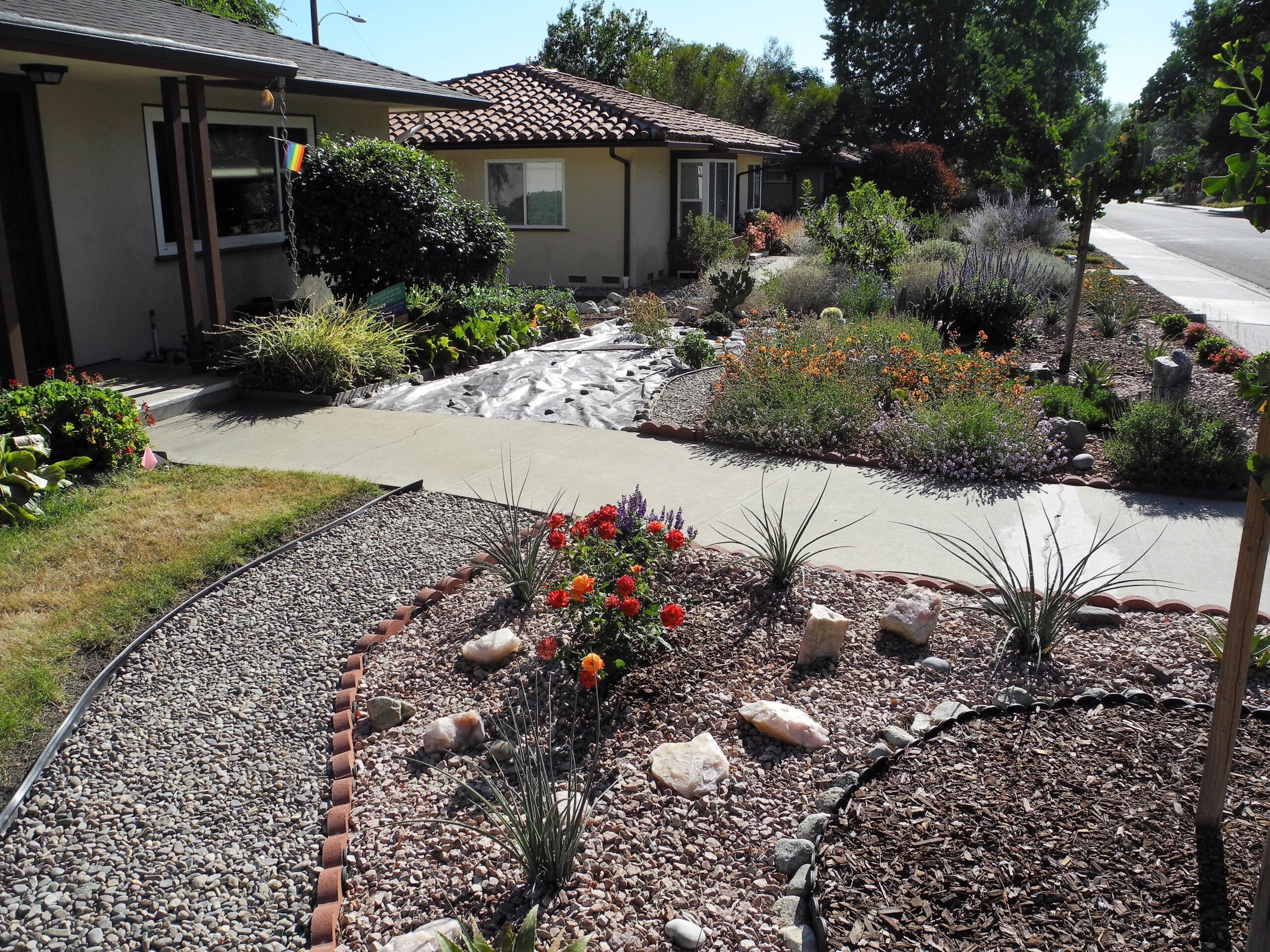
During one of his visits to the Center for Process Studies at the Claremont School of Theology, Charles Hartshorne told me that birds prefer the natural chaos (to our eyes) of wild landscapes; nevertheless, we hope hummingbirds, butterflies, and bees will come to sample the sweet treats in the habitat we are creating.
Note from the Chair
In the Beginning is the Gardening
Where does an ecological civilization begin?
One place it can begin is with our hands, in the ground, growing vegetables: cucumbers, tomatoes, green peppers, eggplants, and lettuce. We can grow them in our backyards if we are lucky enough to have yards; but, where I live, we can also grow them in a local community garden sponsored by the public library.
When we grow them in the community garden, there’s an added benefit. We get to be with other people, young and old, who are also in the growing business. And we can stroll through the library looking at the books and magazines. On Saturdays we can hear lectures by gifted gardeners and music by local singer-songwriters.
We can then walk over to the farmer’s market, three blocks away, and buy vegetables, flowers, and crafts from local vendors. There will be music there, too, and art displays. The spirit is homey and festive, like at the library.
Gradually, as we partake of these communities, we make new friends. We don’t need to talk about it, but we sense a shared hope: a shared “subjective aim” to use the language of process thought. The aim is that the world might become just a little kinder, a little healthier, a little more creative, and that we might play some role in that growth process.
It occurs to us that people in other parts of the world might also share the pleasures of gardening and music, and maybe even the hope for a kinder world.
One of us knows about the Cobb Institute and the work it is doing in China. We remember hearing a talk, on a Tuesday morning, by a fellow gardener, Heran Gao, who lives in an arts-and-gardening township outside Beijing. We contact her and ask if her township might like to partner with us and become part of an arts-and-gardening cohort. She says “yes,” and we begin working on the partnership.
We realize that other friends of the Cobb Institute might also like to partner in this way, forming something like and arts-and-gardening network. We begin to imagine a “community of community of communities” consisting of arts-and-gardening communities spread across the world. They can share best practices and their art as well, through zoom conversations and online chats, with photos of gardens included.
Our dream grows big, but it all begins in a small but beautiful way, very simply, with hands in the ground. Gardening is an act of faith in something healing and whole-making in the world itself, as embodied in plants and soil, friendships and music.
Jesus once said that a vital faith need only be the size of mustard seed. The faith is physical as well as mental. When we touch the Earth and something grows with our help, we are touched by the Earth. We receive a healing energy that is more than us: an energy for life.
The better hope of humanity is not just that we live in peace with one another, it is that we connect with this grace, this healing energy. In the beginning is the gardening.
Jay McDaniel
Community Building
Community Farming Meeting by Michael Witmer
On May 20, 2022, from 9 AM to 5 PM, more than 75 urban farmers, community gardeners, food justice advocates, green space supporters, and environmental stewards gathered from all around the Pomona Valley for a daylong Community Farming Meeting. The event was held at Lopez Urban Farm on W. Mission Avenue in south Pomona. Attendees introduced themselves and their organizations, missions and challenges and throughout the day, connected in small groups to share their ideas, learn about and support each other, and co-create a vision for future collaboration.
The event was inspired by a talk given to the organizers by John Cobb in early April 2022, and was organized by leaders from ten different organizations, included Pomona’s Promise (Healthy Eating Active Living Group), Cal Poly Pomona, Community Partners 4 Innovation, Lopez Community Farm, Esperanza Community Farm, Food Cycle Collective and the Pomona Sustainable Food Alliance (an entity convened by the Cobb Institute in 2019).
The day spawned a number of ongoing working groups, including teams focused on policy advocacy and community organizing; channeling resources to community farming groups; internal communications; and providing a backbone to organize future gatherings on a more regular basis.
For further information or to get involved, please contact us.
Holistic Education
The certificate program is an occasion to learn of the great diversity of process philosophies and the wide variety of ways in which those ideas can be expressed in everyday life. It will begin with a general introduction to process thought and end with an opportunity to creatively and concretely express what participants have learned. In between students will have the opportunity to select from courses that introduce the philosophical foundations of process thought, Christian process theology, understanding religious traditions through the lens of process thought, and applying a process perspective to economics.
We hope that this will be the first of many such offerings in the future, and look forward to having you join us for this experiment in a creative adventure of ideas.
Spiritual Exploration
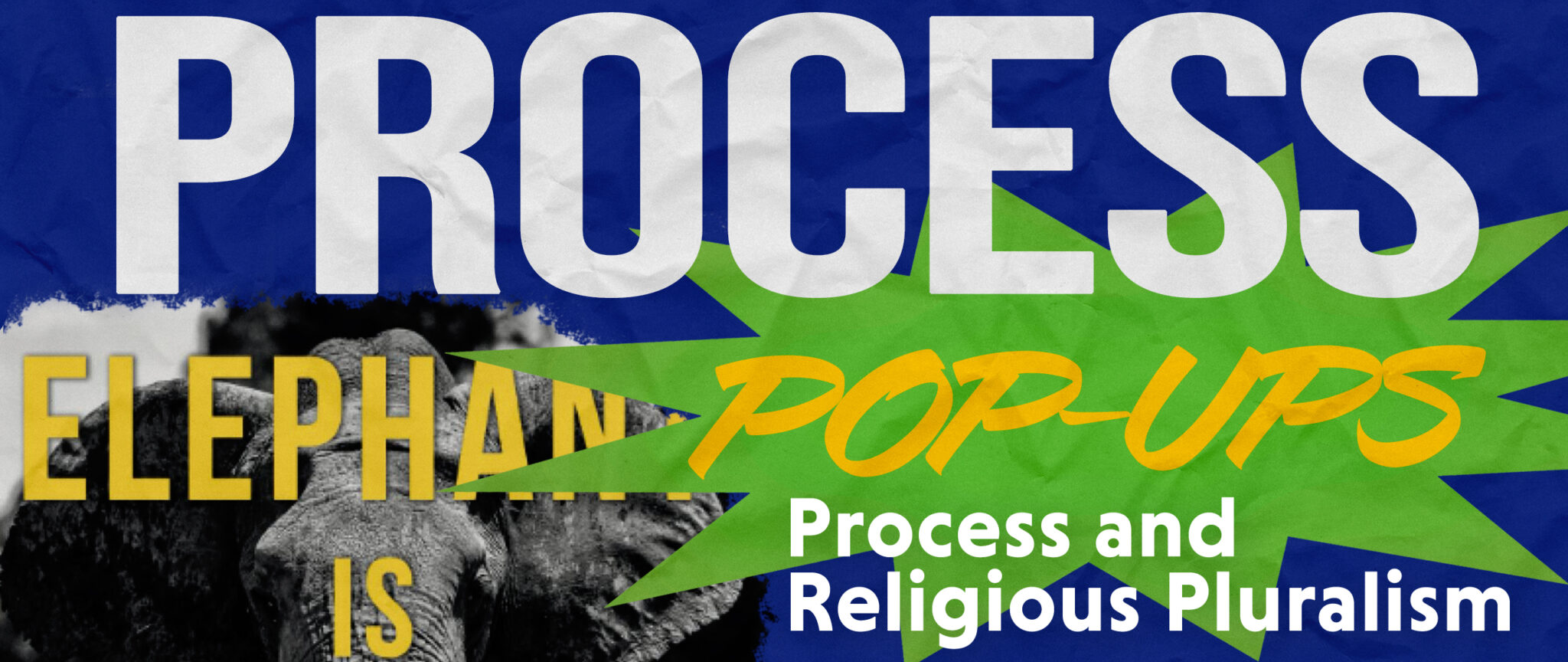
As summer turns to fall is doesn't mean slowing down for Process & Faith. We’ve got a lot going on and invite you to join us for all of the exciting events we are planning.
A Pop-Up, hosted by Bruce Epperly and Sheri Kling, will discuss "Process and Religious Pluralism" using Bruce's recent book as a springboard for discussion. This Pop-Up is on Thursday, August 18th.
All of our previous Process Pop-Ups are also now available to watch on our new Process & Faith YouTube channel! So even if you weren't able to make these previous events, or the upcoming offerings, as a member of the Process & Faith community you can still have access to the full recordings!
There will also be some excellent educational opportunities this Fall, including an international seminar on Process and Human Living with several speakers affiliated with Process & Faith, on Friday, September 30th. This in-depth event is being co-convened with the Network of Spiritual Progressives (Australia) and The Centre for Interfaith Understanding (Singapore).
We’re also developing a multi-session course with Presence International’s Doug King who will talk about his "integral theology" and using the lens of spiral dynamics to understand the biblical narrative as a message of universal God identity. Stay tuned for more information on both offerings.
Process & Faith has also recently expanded its social media presence and you can now find us on Facebook, Instagram, and Twitter. Following these new accounts will be a great way to stay up to date with all the exciting developments at Process & Faith.
Process & Coffee is about spiritual integration and exploration. We meet weekly to dive into books by mystics and sages. The discussion that follows helps to deepen our own spiritual lives. We recently began reading Radical Wholeness: The Embodied Present and the Ordinary Grace of Being.

Everyone is welcome. If you'd like to join us, send an email to learninglab@cobb.institute.
The Arts
The Garden of Oz


On a narrow street, in a hilly neighborhood just below the Hollywood Sign is a secret garden. It’s known as the Garden of OZ. Behind the locked yellow gate is a yellow tiled path that leads to a whimsical garden with almost ever inch tiled over. Yet there is still room for trees and plants. There are tiled thrones to sit upon and enjoy this hidden treasure. To enjoy this garden, one must have a key or an invitation. Gail Cottman is the person responsible for this garden and it's becoming.
I go there every August 6th for a special ceremony. We begin set up at 7am for a Japanese Tea Ceremony in the garden. This is a solemn ceremony.
People arrive a quietly take their places in the small, tiled amphitheater. At 8am a solo cello begins to play. My sensei begins the tea ceremony to the music. At first the music is beautiful and light but soon it begins to change. There is a foreboding feeling stirring up among the crowd. The cello begins a droning sound, almost like an airplane in the distance. The sound grows louder as if the plane is getting closer. My sensei concludes the ceremony and places the honorary bowl on her hand holding still for a moment. The cello droning gets very loud and then suddenly stops as the tea bowl is placed the mat, front and center.
Silence.
Then a bell rings.
It is 8:15am.
I am Hantou (assistant) so I retrieve the bowl and walk up the steps to the center altar that is decorated with stings of hundres of origami canes. I place the bowl and bow deeply.
What everyone in the crowd knows is that, in the early morning hours of August 6, 1945, a B-29 bomber named Enola Gay took off from the island of Tinian and headed north by northwest toward Japan. At approximately 8:15 a.m. Hiroshima time, the Enola Gay released "Little Boy," its 9,700-pound uranium gun-type bomb, over the city. This is what we are remembering.
The event happened over 75 years ago, yet it remains with us. We are called to be better than we were on that day. As talks of nuclear options are once again in the news, we know that every choice affects the world.
A garden can be many things. On every August 6th the Garden of Oz is a memorial garden where we do something beautiful in memory of something horrible.
Kathleen Reeves


A Memorial in the Garden of Oz. Photographs by Kathleen Reeves. Celloist: Steven Velez, Teishu (Tea Ceremony Host): Keiko Nakada. Speaker: Rev. Tomoyuki Hasegawa, Ven. Pandit Dhammaramma



“A garden should make you feel you've entered privileged space -- a place not just set apart but reverberant -- and it seems to me that, to achieve this, the gardener must put some kind of twist on the existing landscape, turn its prose into something nearer poetry.”
―Michael Pollan
John Cobb & Friends Gatherings
August 9: Pauline Doty – Bringing Hope to Our Future
August 16: Ben Bowler – Networking Toward World Unity
August 23. Andrew Davis – Ideas in Process: Ten Whiteheadian Transitions
August 30: Ahmed Afzaal – Teaching at Twilight: The Meaning of Education in the Age of Collapse

Conversations in Process Podcast
Jared Morningstar – Navigating Religious Pluralism in Modernity
On this episode of Conversations in Process, Jay is joined by the Cobb Institute’s operations assistant, Jared Morningstar. Jared is a writer and educator with academic interests in philosophy of religion, Islamic studies, comparative religion, metamodern spirituality, and interfaith dialogue whose work in these areas seeks to offer robust responses to issues of inter-religious conflict, contemporary nihilism, and the "meaning crisis" among other things.


Kazi Adi Shakti – Why Buddhism is Basically Useless and Why That is Good News
On this episode of Conversations in Process, Jay McDaniel and Jared Morningstar are joined by Kazi Adi Shakti to discuss her provocative and nuanced essay “Buddhism is Basically Useless”. Kazi is an artist and theorist whose theoretical work primarily consists in the study and creative synthesis of process thought, Madhyamaka Buddhism, Western Marxism and Eco-feminist ethics.
The Latest From Our Blogs
Process in Praxis
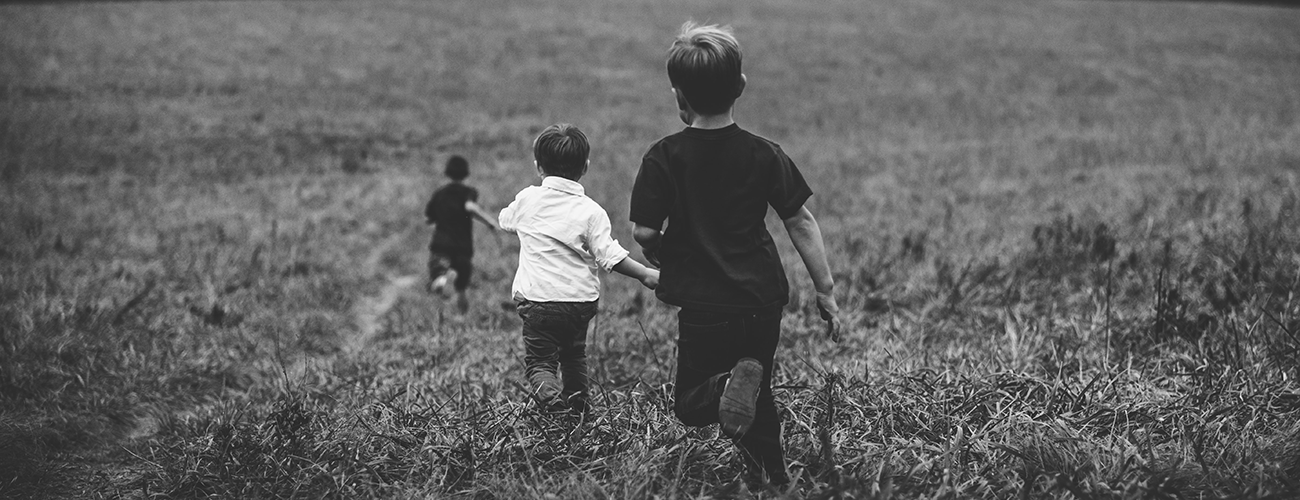
Stepping in the River
By John Roedel
Comedian turned poet John Roedel takes on his journey of “becoming” with a surprising number of vocations. Roedel has been changed along the way. He is going with the flow because as Heraclitus said, “No man ever steps in the same river twice. For it’s not the same river and he’s not the same man.”
Novel Becomings

Suddenly an Artist
By Ken Grunewald
Ken Grunewald is an artist, but he only discovered his talent a few years ago. Before retirement Ken worked in military intelligence. It took a pandemic for him to discover his interest in and talent for drawing. We are all constantly becoming, and Ken became an artist.
What's new on our bookshelf?

A BETTER WAY TO BUY BOOKS ONLINE
The Cobb Instutute is part of Bookshop.org. Bookshop.org began as an idea to help support bookstores and their communities at a time when more and more people were buying their books online. We saw an opportunity to create an alternative to Amazon for socially-conscious online shoppers. Amazon sells over 60% of all books in the US and is growing. That shift threatens the future of bookstores and will hurt readers, authors, and publishers who rely on a diverse, healthy ecosystem for books. We had a better idea — give readers the convenience of online shopping while supporting independent bookstores at the same time.
Bookshop.org launched in January of 2020, with just 88 bookstore partners and a team of four passionate book people. As the COVID-19 pandemic surged, our growing platform helped our community of independent booksellers survive shutdowns. That spring, traffic to Bookshop.org hit 1 million users in a single day. By the end of 2020 we had grown to over 1,000 bookstores, raised over ten million dollars for our profit-sharing pool, and 78% of our customers said they regularly bought books from Amazon before they made the switch.
As a Climate Neutral company, we are committed to operating sustainably. Certified as a B Corp, Bookshop.org puts our mission and the public good above financial interests, giving over 80% of our profit margin to independent bookstores. It is written in our governance documents that we will never sell the company to Amazon or any major U.S. retailer.
Bookshop.org partners with over 1,400 independent bookstores.
Philosophy and Psychedelics: Frameworks for Exceptional Experience
by Christine Hauskeller (Editor), Peter Sjöstedt-Hughes (Editor)
In this rapidly growing area of study, this is the first volume to explore the philosophy of psychedelic experience, from a range of interdisciplinary and cross-cultural perspectives. In doing so, Philosophy and Psychedelics reveals just why the place of psychedelics in our societies should not be left to medical sciences alone, as psychedelic experience opens up new perspectives on fundamental philosophical questions relating to human experience, ethics, and the metaphysics of mind.
Mapping a range of philosophical responses to the surge in studies into psychedelic drugs in the cognitive sciences, this go-to volume examines topics including psychedelics and the role of governance; psychedelics and mysticism; what psychedelics can tell us about dyadic thankfulness; and psychedelics as ways to gain new knowledge.
Written by leading international scholars, the essays cover Western and non-Western traditions, from analytic philosophy to Zen Buddhism, and discuss a variety of hallucinogens, such as LSD, MDMA, and Ayahuasca, in order to build a much-needed bridge between the rapidly growing scientific research and the philosophy behind psychedelic experience.
Lone Leaf Dancing
by Dwayne Cole
In his poetry, Dwayne Cole brings us along on a journey through the seasons where trees are our companions. His poems go deeper than mere appreciation for these trees. These poems are about friendships with trees and their healing power. Dwayne recognizes the interconnected web of life and that we are indeed in relationship with the world. The relationality of our world is beautiful. Yet, we often take it for granted. The trees share their secrets, and Dwayne helps us to hear. Trees offer us so much when they remain standing. Dwayne's poetry spotlights the eros of the world in his prose full of beauty, passion, and gratitude. His photography helps us see through his eyes and we in turn are inspired. Take this book to a wild place, sit under a tree, and fall in love! ~Kathleen Reeves
by Malcolm Torry
Two streams run through the Western philosophical stream: one characterized by Being, beings, the unchanging, the static, and the unitary; and the other by Action, actions, the changing, the dynamic, and the diverse. The former might be represented by Parmenides, Plato, and much of what followed; the latter by Heraclitus, and by rather less of what followed. The book explores the “Action” stream as it wound its way through history, through Heraclitus, Plato, Aristotle, Hegel, Maurice Blondel, Henri Bergson, Pierre Teilhard de Chardin, process philosophy and theology, Geoffrey Studdert Kennedy, Ludwig Wittgenstein, and John Boys Smith.
The journey enables us to create the beginnings of an “actology”: a way of seeing ourselves, the universe, and God in terms of actions in patterns rather than as beings that change. Such an actology offers a complete alternative narrative far more in tune with the diverse and rapidly changing world in which we live than the ontology that has shaped philosophy, theology, and much else for the past two thousand years.
Reciprocal Causality in an Event-Filled World Hardcover
by Joseph A. Bracken S.J.
Given the current sense of helplessness in dealing with environmental change and other urgent issues, a new world view is needed that emphasizes the unique contribution that individual citizens can make to the common good as opposed to their individual needs and desires. In a recent encyclical on the environment, Pope Francis set forth reasons from Scripture and Church teaching for this shift in perspective, but he did not provide a philosophically based foundation for this change of heart. To fill that gap, Joseph Bracken examines key writings of process-oriented philosophers like Henri Bergson and Alfred North Whitehead along with systems-oriented thinkers like Ludwig von Bertalanffy and Ervin Laszlo to create a systems-oriented understanding of the God-world relation.
Process Thought and Roman Catholicism: Challenges and Promises
by Marc A. Pugliese (Editor, Contributor), John Becker (Editor, Contributor)
This collection of essays explores convergences and divergences between process thought and Roman Catholicism with the goal of identifying reasons for why process philosophy and theology has not had the same impact in Roman Catholic circles as in Protestantism, and of constructively navigating avenues of promising engagement between Process thought and Roman Catholicism. In creatively considering the Roman Catholic tradition from the vantage point of Process thought, different theoretical perspectives are brought to bear on Catholic characteristics of historical theology, fundamental theology, systematic theology, moral theology, social justice, and theology of religions. While the contributors draw upon a broad range of resources from the disciplines of the physical and social sciences, philosophy, and ethics from a process perspective, the primary methodology employed is theological reflection.
Divine Appearances: Transreligious Aspects of the Baha'i Discourse on the Manifestation of God
by Roland Faber (Author)
What are we to make of our world with its diverse religions and their endless competing claims to Ultimate Truth? There is a tremendous diversity of perspectives between religions, yet there are teachings within each religion that try to find unity within this diversity. Central to the Baha'i Faith is the teaching that unity in diversity should be a catalyst for greater fellowship between believers. Not in competition, but in a flowering of a new enlightenment founded on the principle of oneness; of God, religion, and humanity.
In Roland Faber’s exciting and profound exploration of this theme he offers new insights into Baha’i thought by taking a deep dive into the Baha'i Scriptures. He explores the mystical and philosophical dimensions of the Baha’i Writings in dialogue with Daoist, Hindu, Buddhist, and Sufi teachings, along with a provocative essay that brings Baha’i ideas into discourse with the work of early 20th-century American philosopher and mathematician Alfred North Whitehead.
From Cosmos to Cradle: Meditations on the Incarnation
by Bruce G Epperly
This book takes its inspiration from the familiar Gospel Nativity stories—but it is far more than a Christmas book. As we revisit the characters of the familiar Christmas stories, we are invited to a new understanding of the Incarnation. We realize that, like Mary, we too are called to be the wombs and midwives of Divine revelation. We may receive Divine guidance and inspiration in dreams, just as Joseph did, and like him, find the courage to go against our society's expectations. Like the shepherds, we are welcomed to see the ongoing glorious pageant of God-made-flesh. And finally, we learn from the magis' example to widen our spiritual horizons and explore new paths.
In Jesus, the Word is made flesh; God has skin, cells, a reproductive system, and circulatory system. Our own souls and cells also reveal God’s artistry, for they too embody the Source of all life. In fact, incarnation is everywhere we turn, revealing the marriage of Creator and creature in all its messiness. Embodiment in all its wonder declares the glory of God—and calls us to build a world where justice and kindness replace oppression and violence.
Silverton Stories: A Collection of Stories from the San Juans
by Cynthia H. Chertos
A book by a member of the Cobb Institute Community of Friends
Life, Love, Struggle, and Laughter through the decades, from the 1880s to the 2010s, one short story for every ten-year span, bringing you true-to-life characters, their triumphs and tribulations, their journeys and lessons learned, all with humor and insight, pathos and cheer.
Fourteen Short Stories that not only show the history of Silverton, Colorado — but the progress and spirit of its people, their hopes and dreams, and even, yes, their disappointments and missed opportunities: the early days of miners to the modern lives of people just trying to find their way home.













